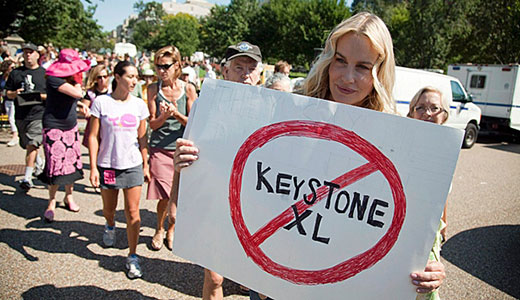
The proposed construction of the Keystone XL pipeline has prompted protests from multiple groups and organizations, including environmentalists, indigenous people, and some labor unions. As the southern leg of the pipeline is currently being built, it is generating waves of outrage, which were only exacerbated by a recent environmental impact statement by the U.S. State Department, which claimed there would be no significant harmful impact from building the pipeline.
That State Department report, instead of addressing the concerns of pipeline opponents, talked around the environmental problems by saying that the global warming that is happening would probably still be happening, even without the pipeline.
The pipeline, owned by the TransCanada Corporation, was first proposed back in 2005, and is slated to carry tar sands oil from Alberta, Canada, to the U.S. Gulf Coast – notably, two areas that have endured seemingly endless grief and environmental damage from oil disasters. The pipeline would transport 830,000 barrels of oil per day, running roughshod through sensitive ecosystems and indigenous lands to do so. Major environmental groups have been opposed to Keystone XL from its inception, with other activists across the country backing their stance. Some unions, like the Laborers’ International Union of North America, have come out in support of the project, touting it as a jobs creator. Their stance is understandable given the extent of joblessness in our country. But others including the National Nurses Union have lent their voice to those of the anti-Keystone XL movement.
Keystone XL backers’ arguments that the project ought to be championed as a jobs provider are being disputed. Many, including some labor activists, feel that the pipeline issue does not need to be divisive, and that they and environmentalists share the same underlying interests.
“Nurses will continue to oppose construction of this project,” said Jean Ross, a registered nurse and NNU’s co-president, “and will call on Obama to stand with our patients and our communities, not the big oil interests, to reject Keystone.”
James C. Little, president of the Transport Workers Union, and Larry J. Hanley, president of the Amalgamated Transit Union, released a joint statement agreeing with the NNU’s stance. They said, “We call on the State Department not to approve construction of the Keystone XL pipeline or to take any actions that lead to the further extraction of tarsands oil from Alberta, Canada. We share the Environmental Protection Agency’s concerns over the potential impacts to groundwater resources from pipeline spills, and the inevitable damage to the health of communities affected by the increase of tarsands refinery emissions.”
Many commentators feel that the State Department’s analysis of the pipeline’s impact was inconclusive and did not show definitively that President Obama should approve the pipeline in its entirety. 350.org writer Duncan Meisel noted, “It avoids the glaringly obvious fact that a pipeline carrying 800,000 barrels per day of the world’s dirtiest oil would be a disaster for the climate and the lives of indigenous communities, farmers, and homes along the route.”
350.org Executive Director May Boeve called the impact statement “a green light to escalate our efforts. This fight got started at the national level when 1,253 people got arrested in front of the White House. We expect many more people will take part in civil disobedience and take to the streets before this fight is over.”
Those words have already proven true, for hundreds of actions in opposition to the pipeline are erupting nationwide, with many others planned. Several hundred protesters gathered in Washington D.C.’s Lafayette Park on Feb. 3 – merely one of 300 protests that took place across the country that day. These events were organized by groups such as 350.org, the Sierra Club, the Center for Biological Diversity, the Natural Resources Defense Council, the League of Conservation Voters, Rainforest Action Network, and a plethora of others.
The fightback wasn’t limited to specifically environmental organizations. Feb. 6 once again showed that Keystone XL is an across-the-board issue: An alliance of Native American communities held a demonstration in Detroit that day, part of the “Idle No More” First Nations Canadian-U.S. movement against the pipeline.
Those indigenous groups released a joint statement entitled No Keystone XL Pipeline Will Cross Lakota Lands. In it, they said, “We stand with the Lakota nation, we stand on the side of protecting water, we stand for indigenous land-based ways of life which will not be corrupted by a hazardous, toxic pipeline. Keystone XL will not cross over reservation boundaries. If [the continued construction of the pipeline] does get approved, we aim to stop it.”
Friends of the Earth, an environmental group that also led demonstrations this week, called Keystone XL “an environmental crime in progress,” and came out in support of the indigenous groups’ plight. “Important parts of their cultural traditions and livelihood are coming under attack because of tar sands operations,” Friends of the Earth said. “Not only have some communities been forced off their land, there are also those that are living downstream from [oil-tainted water sources] who have seen spikes in rates of rare cancers, renal failure, lupus, and hyperthyroidism. These problems will only get worse unless tar sands production is halted.”
Those who share a justified concern about job growth may want to look at the jobs that can be provided by alternate, cleaner energy. Last year, research group The Solar Foundation released a report that found solar jobs to be booming in states including New Jersey, California, Arizona, Texas, and Michigan. “There are more solar energy workers in Texas than ranchers,” the report found. “In California, they outnumber actors, and nationwide, America now has more solar workers than coal miners.”
Solar workers who are employed installing solar panels typically make $38,000 per year, the study found – slightly more than the median national wage of $34,750, according to the Bureau of Labor Statistics (which The Solar Foundation used as a source for its study). The solar industry was found to employ 119,000 people throughout the U.S. in 2013, a 13 percent increase from 2012. This is one of the fastest growth rates for any energy industry, and those numbers are increasing annually. If the concern of some activists is what effect opposing Keystone XL will have on jobs, many feel they need to look carefully at what is happening in the solar industry.
“We need jobs,” concluded union leaders Little and Hanley, “but not ones based on increasing our reliance on tar sands oil. There is no shortage of water and sewage pipelines that need to be fixed or replaced, bridges and tunnels in need of emergency repair, transportation infrastructure that needs to be renewed and developed. Many jobs could also be created that help us reduce air pollution, greenhouse gas emissions, and improve energy efficiency. Energy conservation and climate protection” will become the new means of “putting people to work and laying the foundations of a green and sustainable economic future for the United States.”
Photo: AP

MOST POPULAR TODAY

High Court essentially bans demonstrations, freedom of assembly in Deep South

Zionist organizations leading campaign to stop ceasefire resolutions in D.C. area

U.S. imperialism’s ‘ironclad’ support for Israel increases fascist danger at home


UN warns that Israel is still blocking humanitarian aid to Gaza






Comments